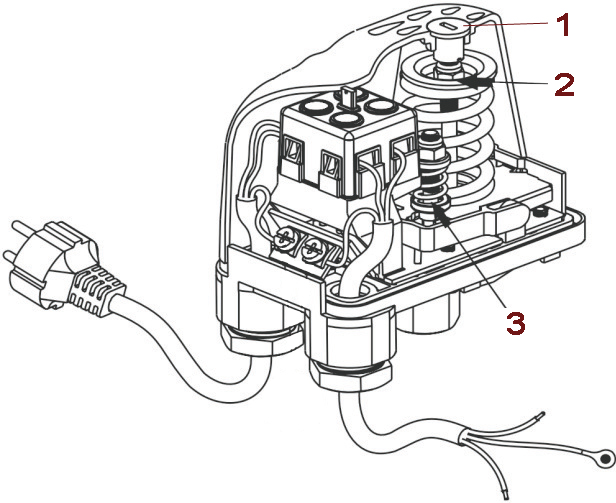Information - Water pumps, booster sets
Pressure switch adjustment
Pressure switch adjustment
Author Akvedukts
One of the most important components of a pumping station or water booster set is a pressure switch. It ensures that the water pump is turned on and off depending on the change in pressure in the water supply system, so adjusting the pressure switch is important both when installing the water pump and later during operation. A distinction is made between mechanical pressure switches and digital pressure switches. A manual for setting up digital pressure switches will be supplied with the product. The adjustment of mechanical pressure switches in most cases will be the same even for products from different manufacturers.
The main components of the pressure switch
The mechanical part of the pressure switch is protected by a cover, therefore, before carrying out adjustment work, its cover must first be removed to gain access to the adjusting nuts. The cover is usually screwed on with a plastic bolt (figure - item 1).

The pressure switch mechanism is controlled by two nuts, each of which tensions the spring (figure - pos. 2 and 3). The pressure switch is adjusted by changing the tension of these springs - by compressing or loosening it. Each of the springs has its own task:
2 – when the tension of the large spring changes, the pump-on pressure P1 and the pump-off pressure P2 change simultaneously (while maintaining the value of the differential pressure ΔP)
3 – a small spring changes the ΔP, i.e. pressure difference between cut-in and cut-out pressures.
Pressure symbols
To adjust the pressure switch, it is necessary to understand the pressure symbols. P1 – switch-on pressure, i.e. pressure at which the relay will turn on the water pump. P2 – switch-off pressure, i.e. pressure at which the relay will turn off the water pump. ΔP – the difference between P1 and P2 , or P2 - P1 = ΔP.

For example, if the pump switch-on pressure P1 is 1.7 bar and ΔP is 1.3 bar, then the pump switch-off pressure P2 will be 3.0 bar
Pressure switch adjustment
If the existing settings of the pressure switch do not meet the requirements of the water supply system, then they must be changed. Adjustment can be carried out if a pressure gauge is installed and it is well read. Work on adjusting the springs of the pressure switch should only be carried out when it is disconnected from the power source! Adjust as follows:
1. Turn on the pumping station (water booster set), wait until it fills the water supply system and turns off
2. Read the pressure value on the pressure gauge (eg 3 bar)
3. Open one of the taps in the water supply system and wait for the pressure to drop to a level at which the pump will turn on
4. Read this pressure on the pressure gauge (eg 1.7 bar)
5. Unscrew the cap screw of the pressure switch (1) and remove the cap
6. Adjust the differential pressure ΔP of the pump using the small spring (3); tightening the spring nut will increase the ΔP value and loosening the nut will decrease
- Changing the value of the differential pressure ΔP also changes the value of the switch-on pressure P1 and the switch-off pressure P2.
- When adjusting the pressure switch, it is recommended to first fully release the small spring (the ΔP value will be as small as possible), and then adjust the on/off pressure.
7. When the desired ΔP value is set, adjust the on/off pressure of the pump with the large spring (2); tightening the large spring nut will increase the on/off pressure, loosening the nut will decrease it. It should be noted that both the cut-in pressure and the cut-out pressure will change in the same way, since the differential pressure ΔP does not change. After changing the pressure, do not forget to change the back pressure in the pressure tank of the booster set ( read here ).
8. After making each change, repeat steps 1-4 until the desired cut-in/cut-out pressure and differential pressure are reached.
9. When the required values are reached, install the cap on the pressure switch and fix it with the bolt (1).
10. Mechanical pressure switch settings are approximate. In cases where you need to set very precise pump on and off values, use a digital pressure switch.
Pressure switch malfunctions and troubleshooting
| Pressure switch failure | Possible cause and troubleshooting |
|---|---|
| The pressure switch constantly turns the pump on and off (the relay twitches) | 1. If the pump capacity allows, increase the on/off pressure to the limit at which the pump runs stably |
| 2. Problem with back pressure in pressure tank; check backpressure and pressure tank diaphragm | |
| 3. (for a new system) the pressure switch is located in the part of the system where temporary pressure surges occur. The position of the pressure switch needs to be changed to a more stable pressure zone | |
| The pump does not turn off even though the taps are closed | 1. The pump cannot reach the maximum pressure set on the pressure switch (start pressure + differential pressure); it is necessary to reduce the differential pressure (it is necessary to loosen the small spring by unscrewing the nut) or reduce the switching pressure (weaken the large spring by unscrewing the nut) |
| 2. Pressure drop too high - loosen small spring nut (3). | |
| The pressure switch turns on / off the pump only when tapping on the relay housing | The mechanism of the pressure switch has developed, the relay needs to be replaced with a new one |
| The shower has variable pressure and water temperature | When the shower faucet is open, the pump periodically turns on and off; the resistance in the cold and hot water lines is different, so the pressure in the cold and hot water lines also changes and, as a result, the temperature of the water in the shower changes. What needs to be done is to adjust the pressure switch so that the pump does not turn off during the shower (check if it turns off after the shower tap is closed) |
Pressure switch location
The rate of propagation of fluid pressure changes has an inertial character. The farther the pressure switch is from the pressure tank, the more likely it is to be affected by this inertia. The pressure switch must be located at a reasonable distance from the pressure tank (no further than 1.5–2.0 m).
Pressure switches in Akvedukts E-warehouse


